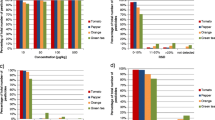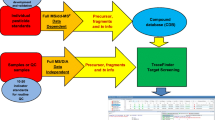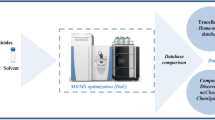Abstract
LC-Q-Orbitrap efficiency was evaluated for pesticide multi-residue analysis by using three workflows involving simultaneous MS and MS2 analysis. They were as follows: data-dependent MS2 (dd-MS2), all-ion fragmentation (AIF) and variable data-independent analysis (vDIA). These MS2 workflows were tested for the main method validation parameters such as detection and identification capabilities, repeatability, linear range and quantitation. QuEChER acetonitrile extracts (blanks and spiked with 166 pesticides) of 11 different fruits and vegetables were used for this evaluation. Blank extracts were analysed to evaluate isobaric compounds and potential false identification. Spiked extracts (at 0.01 and 0.1 mg kg−1) were analysed to evaluate the false negatives potentially produced (considering a retention mass window of 0.2 min). At 0.01 mg kg−1, dd-MS2 had the highest identification rate (96–100%, depending on the matrix). In vDIA, it was 86–100% and in AIF 81–100%. But these two last workflows offered more possibilities for applying screening analysis. It was observed that application of the ion ratio criterion established in the SANTE Guidelines for identification can generate some artificial false negative results. It could be overcome by considering a mass error threshold (i.e. 5 ppm) as a selected criterion. Detection and quantitation were carried out in full-scan MS. MS2 data were used for identification. Dd-MS2 provided the highest number of points per chromatographic peak, and by that peak area, repeatability was the best (typically <10%). AIF and vDIA were characterised by longer cycle times; thus, the obtained peak area repeatability was slightly worse, but acceptable (<20%). All workflows showed very good linearity in the range 0.01–0.5 mg kg−1. The three MS2 workflows were applied to real samples with good results.

LC-Q-Orbitrap was used for pesticide residues analysis in fruit and vegetables. Three approaches to MS2 identificaton were evaluated







Similar content being viewed by others
References
Kaufmann A. Combining UHPLC and high-resolution MS: a viable approach for the analysis of complex samples? TrAC Trends Anal Chem. 2014;63:113–28. doi:10.1016/j.trac.2014.06.025.
Borràs S, Kaufmann A, Companyó R. Correlation of precursor and product ions in single-stage high resolution mass spectrometry. A tool for detecting diagnostic ions and improving the precursor elemental composition elucidation. Anal Chim Acta. 2013;772:47–58. doi:10.1016/j.aca.2013.02.012.
Kaufmann A. High mass resolution versus MS/MS. Compr Anal Chem. 2012; 58:169–215. doi:10.1016/B978-0-444-53810-9.00001-8.
Kaufmann A, Butcher P, Maden K, Walker S, Widmer M. Reliability of veterinary drug residue confirmation: high resolution mass spectrometry versus tandem mass spectrometry. Anal Chim Acta. 2015;856:54–67. doi:10.1016/j.aca.2014.11.034.
Kaufmann A, Butcher P, Maden K, Walker S, Widmer M. Determination of nitrofuran and chloramphenicol residues by high resolution mass spectrometry versus tandem quadrupole mass spectrometry. Anal Chim Acta. 2015;862:41–52. doi:10.1016/j.aca.2014.12.036.
Kaufmann A, Butcher P, Maden K, Walker S, Widmer M. Comprehensive comparison of liquid chromatography selectivity as provided by two types of liquid chromatography detectors (high resolution mass spectrometry and tandem mass spectrometry): “where is the crossover point?”. Anal Chim Acta. 2010;673(1):60–72. doi:10.1016/j.aca.2010.05.020.
Kaufmann A, Butcher P, Maden K, Walker S, Widmer M. Quantitative and confirmative performance of liquid chromatography coupled to high-resolution mass spectrometry compared to tandem mass spectrometry. Rapid Commun Mass Spectrom. 2011;25(7):979–92. doi:10.1002/rcm.4952.
Kaufmann A. The current role of high-resolution mass spectrometry in food analysis. Anal Bioanal Chem. 2012;403(5):1233–49. doi:10.1007/s00216-011-5629-4.
Rajski Ł, Gomez-Ramos MM, Fernandez-Alba AR. Large pesticide multiresidue screening method by liquid chromatography-Orbitrap mass spectrometry in full scan mode applied to fruit and vegetables. J Chromatogr A. 2014;1360:119–27. doi:10.1016/j.chroma.2014.07.061.
Gomez-Ramos MM, Rajski Ł, Heinzen H, Fernandez-Alba AR. Liquid chromatography Orbitrap mass spectrometry with simultaneous full scan and tandem MS/MS for highly selective pesticide residue analysis. Anal Bioanal Chem. 2015;407(21):6317–26. doi:10.1007/s00216-015-8709-z.
Lehotay SJ, Sapozhnikova Y, Mol HGJ. Current issues involving screening and identification of chemical contaminants in foods by mass spectrometry. TrAC Trends Anal Chem. 2015;69:62–75. doi:10.1016/j.trac.2015.02.012.
Zomer P, Mol HG. Simultaneous quantitative determination, identification and qualitative screening of pesticides in fruits and vegetables using LC-Q-Orbitrap-MS. Food Addit Contam Part A Chem Anal Control Expo Risk Assess. 2015;32(10):1628–36. doi:10.1080/19440049.2015.1085652.
SANTE/11945/2015.http://ec.europa.eu/food/plant/pesticides/max_residue_levels/guidelines_en
Gomez-Ramos MM, Ferrer C, Malato O, Aguera A, Fernandez-Alba AR. Liquid chromatography-high-resolution mass spectrometry for pesticide residue analysis in fruit and vegetables: screening and quantitative studies. J Chromatogr A. 2013;1287:24–37. doi:10.1016/j.chroma.2013.02.065.
Gómez-Ramos MdM, Rajski Ł, Lozano A, Fernández-Alba AR. The evaluation of matrix effects inpesticide multi-residue methods via matrix fingerprinting using liquid chromatography electrospray high-resolution mass spectrometry. Anal Methods. 2016;8(23):4664–73. doi:10.1039/c6ay00436a.
Kaufmann A, Walker S. Extension of the Q Orbitrap intrascan dynamic range by using a dedicated customized scan. Rapid Commun Mass Spectrom. 2016;30(8):1087–95. doi:10.1002/rcm.7530.
Henderson W, McIndoe JS. Mass Spectrometry of Inorganic, Coordination and Organometallic Compounds. Chichester: Wiley & Sons Ltd; 2005.
Holcapek M, Jirasko R, Lisa M. Recent developments in liquid chromatography-mass spectrometry and related techniques. J Chromatogr A. 2012;1259:3–15. doi:10.1016/j.chroma.2012.08.072.
Acknowledgements
The authors would like to thank Thermo Fisher Scientific for facilitating QExactive Focus and for technical support. The authors acknowledge funding support from the European Commission, DG SANTE (Specific Agreement No. 7 to Framework Partnership Agreement No. SANTE/2005/FOOD SAFETY/0025-Pesticides in Fruit and Vegetables).
Author information
Authors and Affiliations
Corresponding author
Ethics declarations
Conflict of interest
The authors declare that no conflict of interest.
Additional information
Published in the topical collection Advances in LC-MS/MS Analysis with guest editors Damià Barceló and Mira Petrovic.
Rights and permissions
About this article
Cite this article
Rajski, Ł., del Mar Gómez Ramos, M. & Fernández-Alba, A.R. Evaluation of MS2 workflows in LC-Q-Orbitrap for pesticide multi-residue methods in fruits and vegetables. Anal Bioanal Chem 409, 5389–5400 (2017). https://doi.org/10.1007/s00216-017-0220-2
Received:
Revised:
Accepted:
Published:
Issue Date:
DOI: https://doi.org/10.1007/s00216-017-0220-2




